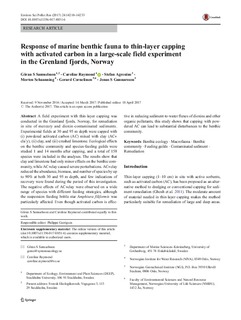Response of marine benthic fauna to thin-layer capping with activated carbon in a large-scale field experiment in the Grenland fjords, Norway
Samuelsson, Göran S.; Raymond, Caroline; Agrenius, Stefan; Schaanning, Morten; Cornelissen, Gerard; Gunnarsson, Jonas S.
Journal article, Peer reviewed
Published version
Permanent lenke
http://hdl.handle.net/11250/2449726Utgivelsesdato
2017Metadata
Vis full innførselSamlinger
Originalversjon
Environmental science and pollution research international. 2017, 24 (16), 14218-14233. 10.1007/s11356-017-8851-6Sammendrag
A field experiment with thin-layer capping was conducted in the Grenland fjords, Norway, for remediation in situ of mercury and dioxin-contaminated sediments. Experimental fields at 30 and 95 m depth were capped with (i) powdered activated carbon (AC) mixed with clay (AC+cla`y), (ii) clay, and (iii) crushed limestone. Ecological effects on the benthic community and species-feeding guilds were studied 1 and 14 months after capping, and a total of 158 species were included in the analyses. The results show that clay and limestone had only minor effects on the benthic community, while AC+clay caused severe perturbations. AC+clay reduced the abundance, biomass, and number of species by up to 90% at both 30 and 95 m depth, and few indications of recovery were found during the period of this investigation. The negative effects of AC+clay were observed on a wide range of species with different feeding strategies, although the suspension feeding brittle star Amphiura filiformis was particularly affected. Even though activated carbon is effective in reducing sediment-to-water fluxes of dioxins and other organic pollutants, this study shows that capping with powdered AC can lead to substantial disturbances to the benthic community.
